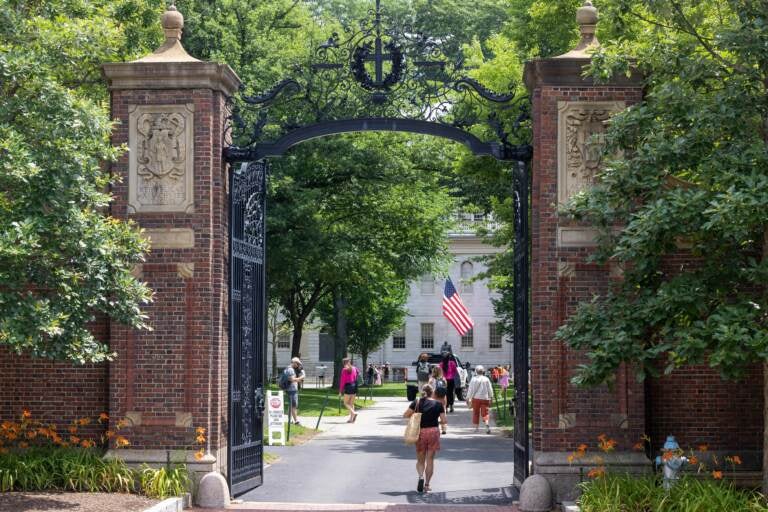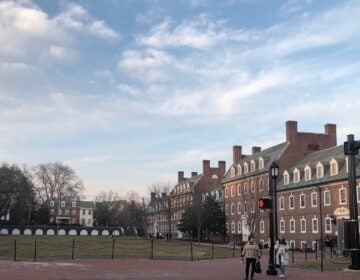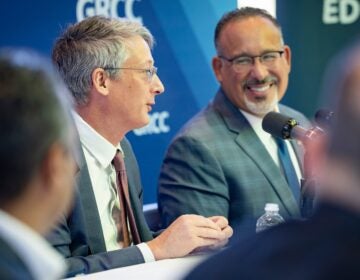Affirmative action for rich kids: It’s more than just legacy admissions

People walk through the gate on Harvard Yard at the Harvard University campus on June 29, 2023 in Cambridge, Massachusetts. (Scott Eisen/Getty Images)
A few weeks ago, the U.S. Supreme Court ended affirmative action in college admissions. The ruling held that the race-conscious admission programs of Harvard University and the University of North Carolina violated the Equal Protection Clause of the Fourteenth Amendment. It’s now deemed unconstitutional for colleges — both public and private — to weigh race as a factor in who they should admit.
Affirmative action for minority kids may now be dead. But a blockbuster new study, released today, finds that, effectively, affirmative action for rich kids is alive and well. They may or may not always do it on purpose, but a group of the most prestigious private colleges in America are handing a massive admissions advantage to rich kids over less affluent kids — even when they have the same SAT scores and academic qualifications.
The study is by Raj Chetty and David J. Deming, of Harvard University, and John N. Friedman, of Brown University. We at Planet Money have already dubbed Raj Chetty the Beyoncé of Economics because of his long list of popular hits in empirical economics. And, let me tell you, this is another ***Flawless classic in his catalog. I mean, not only is the study eye-opening, but Chetty is also kind of sticking his neck out here, by shining a spotlight on the admission practices of his employer, Harvard. But they can’t fire Beyoncé! (He has tenure).
Among a number of other discoveries, the economists find that kids from the richest 1% of American families are more than twice as likely to attend the nation’s most elite private colleges as kids from middle-class families with similar SAT scores. The silver spoon these wealthy kids are born with can, apparently, be used to catapult them past other equally bright, but less privileged kids into some of America’s best colleges.
Chetty and his colleagues provide compelling evidence that fancy schools are promoting a kind of neo-aristocracy, with admission programs that help to perpetuate a family’s class privilege from one generation to the next. The advantages they grant to rich kids are about more than just legacy admissions, a practice in which elite colleges give preferential treatment to kids of alumni and donors. The economists find that other types of evaluation and recruitment play important roles in giving rich kids a leg up, as well.
Going further, the economists find evidence suggesting that reforms to the admissions policies at these prestigious schools could really make a big difference in the life trajectories of less affluent kids, and make America’s elite less of an exclusive club for people born into privilege
Silver spoon-fed schools
Chetty, Deming, and Friedman focus their study on what they call the “Ivy-Plus colleges”: the eight Ivy League schools — Harvard, Princeton, Yale, Columbia, Brown, Cornell, Dartmouth, and UPenn — as well as Stanford, MIT, Duke, and the University of Chicago.
Less than half of 1% of Americans go to these prestigious private colleges. “Yet these twelve colleges account for more than 10% of Fortune 500 CEOs, a quarter of U.S. Senators, half of all Rhodes scholars, and three-fourths of Supreme Court justices appointed in the last half-century,” the economists write. These schools, in other words, appear to be an important gateway to the American elite, which makes their admission policies relevant for all of us.
Rich kids obviously have a bunch of advantages that help them bolster their academic credentials — like great private schools, SAT tutors and so on. Indeed, Chetty and his colleagues have already amassed a ton of evidence that the environment — even the zip code — in which kids grow up has a huge impact on their chances of climbing the economic ladder.
But these childhood advantages are not what this study is about. In this study, the economists compare rich kids and their less affluent peers who have achieved roughly equal academic credentials (measured by SAT scores and GPAs). Yet, even then, the rich kids are still way more likely to get into elite colleges. It’s pretty shocking when you consider how much harder it is for a less well-off kid to measure up academically to a rich kid, who, from a young age, has benefited from tremendous resources aimed at bolstering their academic credentials.
[Editor’s note: This is an excerpt of Planet Money‘s newsletter. You can sign up here.]
The economists pull together a range of large data sources that enables them to thoroughly analyze the admission decisions of America’s most elite colleges. They got internal admissions data from a bunch of schools, allowing them to see which kids applied and which ones got in. They have SAT and ACT test scores. And, equipped with IRS data, the economists are able to see how rich these kids’ families were when they applied to college, and how much money the kids earned after they graduated. They focus primarily on students admitted between 2010 and 2015, which gives them enough of a postgraduate track record for the researchers to see how they’ve done in their careers.
With this treasure trove of data, the economists then embark on a rigorous analysis. First, they establish the overwhelming reason why rich kids are disproportionately attending these schools: admissions. Yes, they find, their less affluent peers are a bit less likely to apply and enroll, but the main reason for the disparity is colleges are systematically admitting more rich kids than less well-off ones.
As previously mentioned, the economists find that wealthy children, even when they have comparable SAT and ACT scores to less affluent kids, are much more likely to get into these elite schools. A student from the richest 1% of American families (from families earning over $611,000 per year) is twice as likely to attend an elite private college as a middle-class student (from a family earning between $83,000-$116,000 per year) with the same academic credentials. The economists find this disparity can only be found at elite private colleges: they find no such advantage for rich kids at America’s flagship public universities, like UC Berkeley or the University of Michigan.
“I think implicitly what we’re finding in the data is that — whether intentionally or not — we currently have a system that appears to have affirmative action for kids from the richest families, the top 1% in particular, which gives them a substantial leg up in admissions relative to other kids,” Chetty says.
Why rich kids are getting admitted more
The economists find three factors that give rich kids this huge admissions boost. The first is legacy admission programs. They calculate that 46% of their admissions advantage comes from programs that give them preferential admission due to their parents being alumni.
One defense for these legacy kids might be that they’re smart, hard-working, and ambitious, so they’d be able to get into another Ivy-Plus college if they wanted to. But the economists find these same legacy kids see no advantage when they apply to schools their parents did not go to. “So, in other words, that legacy impact is totally non-transferrable across colleges, which strongly suggests that it’s not that these kids are just kind of stronger applicants in general,” Chetty says. “It’s actually about literally being a legacy at this college.”
The second reason that rich kids get an admissions advantage is athletic recruitment. The economists calculate that 24% of the admission boost for students from the richest 1% of families comes from the fact that they excel at some sort of sport. That may be somewhat surprising, because if you watch pro sports, the stars usually don’t come from privileged backgrounds. The economists are unable to do a sport-by-sport analysis, but, Chetty says, it’s likely that kids are finding a recruitment advantage in expensive, elite sports, such as fencing, tennis, rowing or lacrosse. Elite private colleges, after all, are generally not known for their stellar football or basketball teams.
The last reason rich kids are more likely to be admitted is because they tend to have higher non-academic ratings that make their applications pop. Think extracurricular activities, compelling letters of recommendation, and guidance counselors who help them engineer perfect resumes and personal statements. This explains about 30% of their advantage.
Chetty says the rich-kid advantage in non-academic ratings is almost entirely driven by the fact that they are much more likely to attend elite private high schools. “If you’re coming from an elite private school, you tend to have much higher non-academic ratings,” Chetty says. “Now, of course, kids from high-income families are much more likely to attend these schools.”
Why the particular college you go to might matter, after all
So, yeah, rich kids are much more likely to get into fancy colleges than less affluent kids. But does that necessarily mean that it really matters for future outcomes? It’s possible that going to one of these elite schools doesn’t have a large effect on a person’s later career. Indeed, there have been some influential economic studies that suggest that the choice of college by similarly qualified students doesn’t have much of an effect on how much they end up making, on average.
The reason for this, economists have long figured, is that elite colleges are highly selective. The kids they admit are smart, hard-working, highly ambitious — and apparently much more likely to come from rich families — which means they have a solid shot at success, whether they go to a particular school or not. Economists call this “selection bias.” The idea is, basically, schools are just selecting winners — not necessarily making winners. Which is why the causal effect of a particular school on a kid’s outcomes might not actually matter very much.
But that’s not what this new study finds. They find that going to these Ivy-Plus colleges makes kids a lot more likely to become tremendously rich and successful. This is especially the case for less affluent kids. “Attending an Ivy-Plus college instead of the average highly selective public flagship institution increases low-income students’ chances of reaching the top 1% of the earnings distribution by 60%, nearly doubles their chances of attending an elite graduate school, and triples their chances of working at a prestigious firm,” the economists write.
So why are these economists finding that the particular school that kids attend matters a great deal, while previous studies have suggested that it doesn’t? Chetty and his colleagues do a bunch of statistical work backing up and double-checking this finding. For example, they use one technique in which wait-listed kids serve as a kind of quasi-experiment. In some cases these kids are admitted from the waitlist for a somewhat random reason, and other times they are not let in. This enables the researchers to compare outcomes of statistically similar students, some of whom went to Ivy-Plus colleges, some of whom went to flagship public colleges. The economists are now able to see what happened to those students over time.
Chetty says that, consistent with previous findings, the data shows that the particular school these students attend doesn’t matter much when it comes to their average earnings. If a bright kid goes to UC Berkeley instead of Harvard, they’ll still make good money working in tech or law, or whatever. Compared to similar kids who did go to Harvard, their earnings, on average, usually won’t look much different.
However, Chetty says, their data is much richer than previous studies, which relied on small surveys instead of the massive administrative datasets that Chetty, Deming and Friedman use in this study. As a result, the economists are able to zero in and see “upper-tail” outcomes like the likelihood of these kids reaching the top 1% of income earners. Previous studies couldn’t see outcomes in the same detail. And that’s where Chetty and his colleagues are finding significant advantages when kids go to these elite private schools.
“These colleges have a huge causal effect on getting you access to the upper tail — to positions of influence, to becoming a leader,” Chetty says. We’re talking about elite positions like corporate executives, U.S. Senators, top professors, Supreme Court justices. “I think what these colleges do is really open doors for some folks to get to a set of positions that they really would not have had much access to had they not gone.”
As a result, Chetty says, reforming admission practices at these schools could have a meaningful impact on what America’s elite looks like. One potential reform they highlight: just use the same admissions criteria as America’s flagship public universities, where it’s more about raw academic credentials, and wealthy children don’t have the same overt admissions advantage.
Admissions in a world after race-based affirmative action
Mind you, Chetty and his colleagues studied admissions data before the recent Supreme Court decision, when most of these schools had some sort of race-conscious affirmative action program. Even in this world, as Chetty and his colleagues found in a previous study, kids from the richest 1% of American families were 77 times more likely to attend an Ivy League college than those from families in the bottom fifth of the income distribution.
Now, with race-based affirmative action dead, it’s plausible that the underrepresentation of lower and middle-class families at these schools could look even worse in coming years, because race is strongly correlated with income and wealth.
In the wake of the Supreme Court decision, we’ve begun to see a national debate about admissions policies at America’s elite schools. Just days after the ruling, a group of advocacy organizations filed a complaint against Harvard for their legacy admissions policy, arguing that it primarily benefits the kids of wealthy, white families. President Biden criticized legacy admissions and other similar policies that “expand privilege instead of opportunity.” And a wave of universities, including Wesleyan, Carnegie Mellon, and MIT — one of the “Ivy-Plus” schools in this study — have begun ending their legacy admission programs.
But many schools, including the majority of the Ivy-Plus colleges, are still clinging to their legacy admission programs. If their goal is to have their students go on and make a significant impact on society, Chetty and his colleagues find, that doesn’t make a lot of sense. They find that rich kids who are admitted because of their legacy status or their athletic background or their non-academic ratings are actually a bit less likely to see outsized success after graduating, compared to middle- or lower-class kids who don’t have those credentials. The economists find that raw SAT and ACT scores — and, more generally, academic ratings like GPA — are much more predictive of future success than anything else.
Of course, these colleges may still be reluctant to end their programs that give a leg up to the richest kids in America. The colleges assert that legacy programs help build community and school loyalty. Probably more relevant is the importance of legacies to these fancy private colleges’ business models: rich kids are more likely to pay tuition — and their parents are more likely to give donations and pad their endowments.
As for concerns that diversity at these schools is about to plummet because of the end of race-conscious affirmative action, Chetty has some ideas to promote both racial and socioeconomic diversity that may survive judicial scrutiny.
It would be an admission process that would take into account “kids who come from neighborhoods that have particularly low levels of upward mobility and use that as a measure of adversity,” Chetty says. This would not be explicitly focused on race itself, but it would pick up “the adversity in childhood environments that is correlated with race.”
Call it zip code-based affirmative action. After all, if you grow up in a poverty-stricken neighborhood and manage to score a 1500 on the SATs, you’ve jumped over a much higher hurdle than your silver-spoon-fed competition.
9(MDAzMzI1ODY3MDEyMzkzOTE3NjIxNDg3MQ001))




